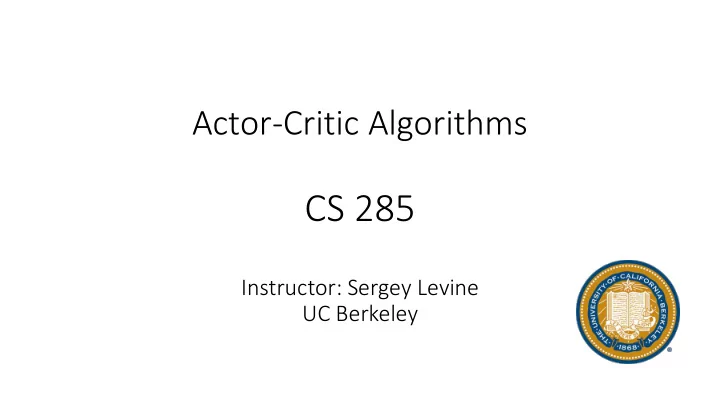

Actor-Critic Algorithms CS 285 Instructor: Sergey Levine UC Berkeley
Recap: policy gradients fit a model to estimate return generate samples (i.e. run the policy) improve the policy “reward to go”
Improving the policy gradient “reward to go”
What about the baseline?
State & state-action value functions fit a model to estimate return generate samples (i.e. run the policy) improve the policy the better this estimate, the lower the variance unbiased, but high variance single-sample estimate
Value function fitting fit a model to estimate return generate samples (i.e. run the policy) improve the policy
Policy evaluation fit a model to estimate return generate samples (i.e. run the policy) improve the policy
Monte Carlo evaluation with function approximation the same function should fit multiple samples!
Can we do better?
Policy evaluation examples TD-Gammon, Gerald Tesauro 1992 AlphaGo, Silver et al. 2016
From Evaluation to Actor Critic
An actor-critic algorithm fit a model to estimate return generate samples (i.e. run the policy) improve the policy
Aside: discount factors episodic tasks continuous/cyclical tasks
Aside: discount factors for policy gradients
Which version is the right one? Further reading: Philip Thomas, Bias in natural actor-critic algorithms. ICML 2014
Actor-critic algorithms (with discount)
Actor-Critic Design Decisions
Architecture design two network design + simple & stable - no shared features between actor & critic shared network design
Online actor-critic in practice works best with a batch (e.g., parallel workers) synchronized parallel actor-critic asynchronous parallel actor-critic
Critics as Baselines
Critics as state-dependent baselines + lower variance (due to critic) - not unbiased (if the critic is not perfect) + no bias - higher variance (because single-sample estimate) + no bias + lower variance (baseline is closer to rewards)
Control variates: action-dependent baselines + no bias - higher variance (because single-sample estimate) + goes to zero in expectation if critic is correct! - not correct use a critic without the bias (still unbiased), provided second term can be evaluated Gu et al. 2016 (Q-Prop)
Eligibility traces & n-step returns + lower variance - higher bias if value is wrong (it always is) + no bias - higher variance (because single-sample estimate) Can we combine these two, to control bias/variance tradeoff?
Generalized advantage estimation Do we have to choose just one n? Cut everywhere all at once! weighted combination of n-step returns How to weight? Mostly prefer cutting earlier (less variance) exponential falloff similar effect as discount! remember this? discount = variance reduction! Schulman, Moritz, Levine, Jordan, Abbeel ‘16
Review, Examples, and Additional Readings
Review • Actor-critic algorithms: • Actor: the policy fit a model to • Critic: value function estimate return • Reduce variance of policy gradient generate • Policy evaluation samples (i.e. • Fitting value function to policy run the policy) • Discount factors improve the • Carpe diem Mr. Robot policy • …but also a variance reduction trick • Actor-critic algorithm design • One network (with two heads) or two networks • Batch-mode, or online (+ parallel) • State-dependent baselines • Another way to use the critic • Can combine: n-step returns or GAE
Actor-critic examples • High dimensional continuous control with generalized advantage estimation (Schulman, Moritz, L., Jordan, Abbeel ‘16) • Batch-mode actor-critic • Blends Monte Carlo and function approximator estimators (GAE)
Actor-critic examples • Asynchronous methods for deep reinforcement learning (Mnih, Badia, Mirza, Graves, Lillicrap, Harley, Silver, Kavukcuoglu ‘16) • Online actor-critic, parallelized batch • N-step returns with N = 4 • Single network for actor and critic
Actor-critic suggested readings • Classic papers • Sutton, McAllester, Singh, Mansour (1999). Policy gradient methods for reinforcement learning with function approximation: actor-critic algorithms with value function approximation • Deep reinforcement learning actor-critic papers • Mnih, Badia, Mirza, Graves, Lillicrap, Harley, Silver, Kavukcuoglu (2016). Asynchronous methods for deep reinforcement learning: A3C -- parallel online actor-critic • Schulman, Moritz, L., Jordan, Abbeel (2016). High-dimensional continuous control using generalized advantage estimation: batch-mode actor-critic with blended Monte Carlo and function approximator returns • Gu, Lillicrap, Ghahramani, Turner, L. (2017). Q-Prop: sample-efficient policy- gradient with an off-policy critic: policy gradient with Q-function control variate
Recommend
More recommend